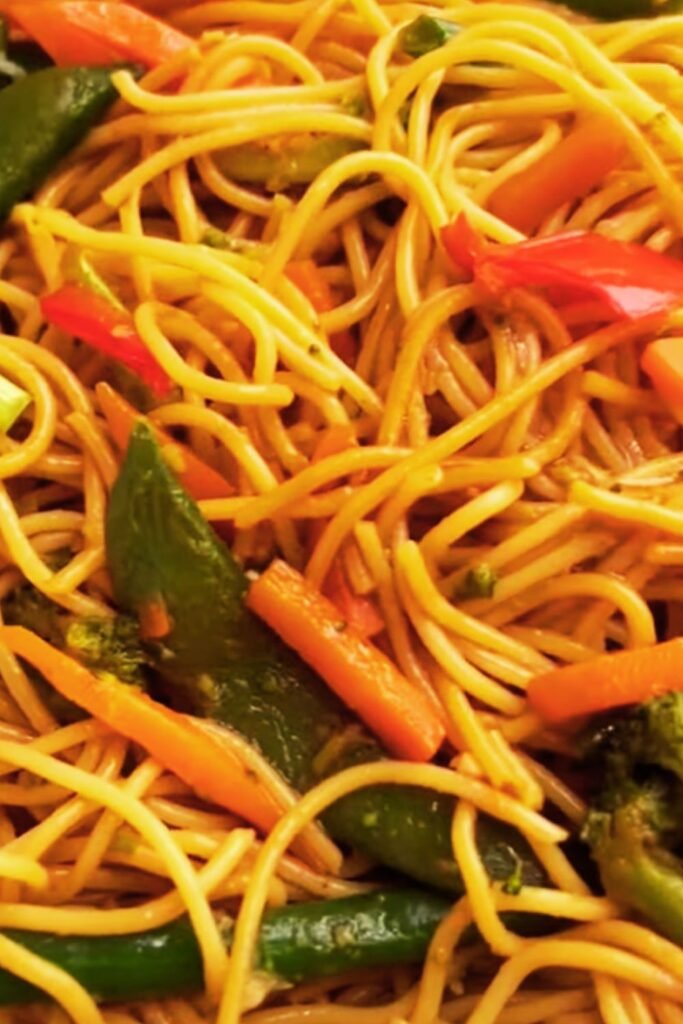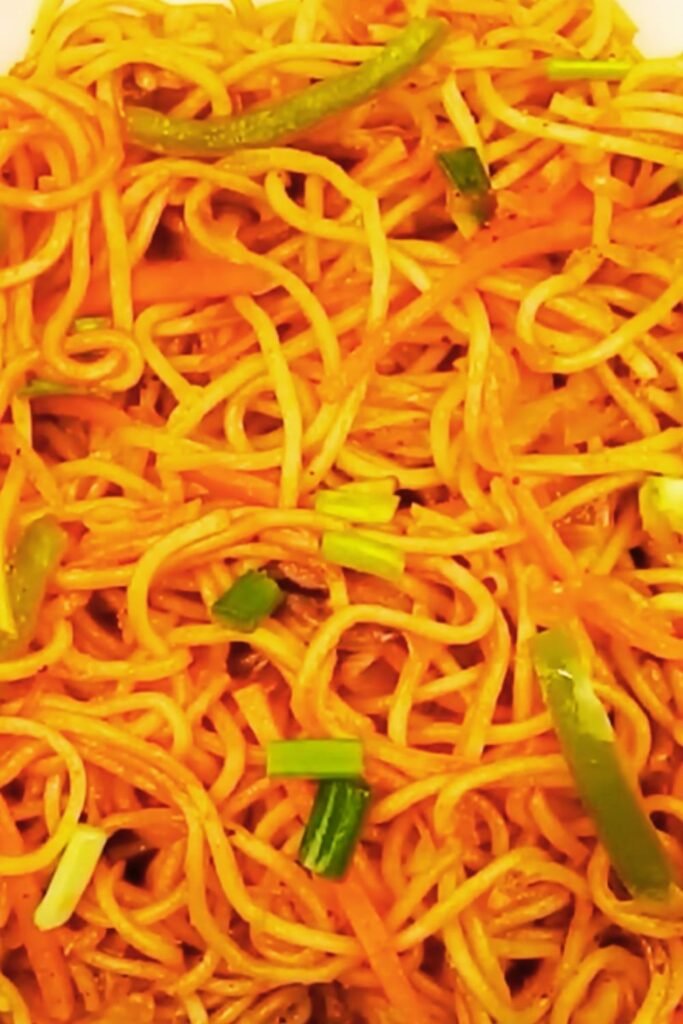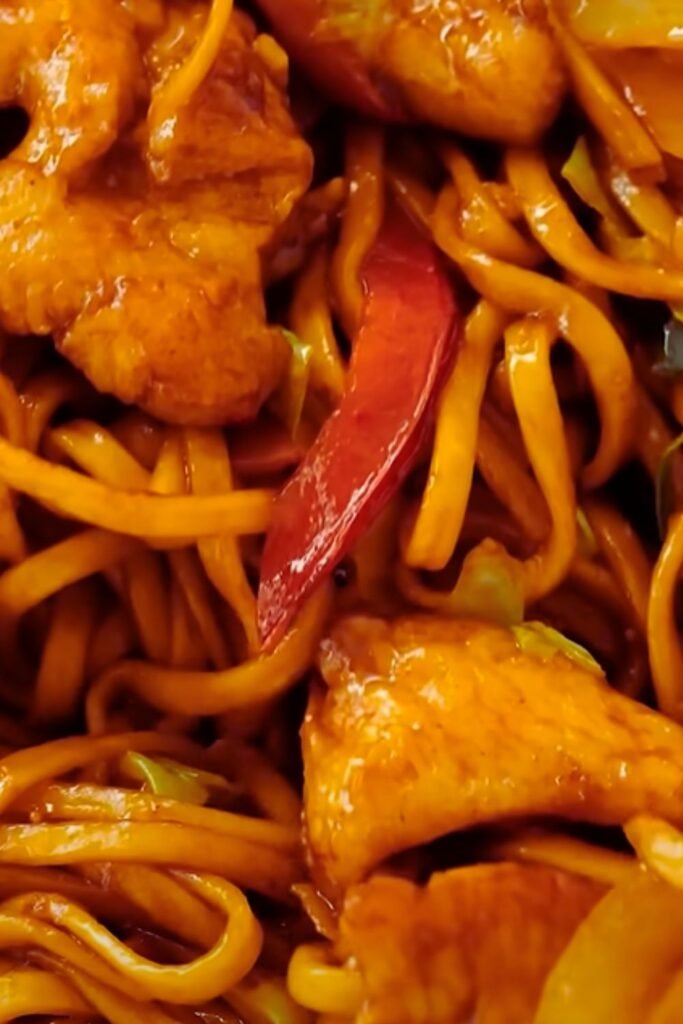Have you ever found yourself staring into your refrigerator at 6 PM on a Tuesday, wondering how to transform those random vegetables and that package of noodles into something delicious? I’ve been there more times than I can count! That’s why I’m absolutely thrilled to share my go-to weeknight savior: Easy 20-Minute Lo Mein Noodles. This dish has rescued countless hectic evenings at my house, turning potential takeout nights into satisfying homemade meals that everyone loves.
Lo mein might sound fancy, but it’s actually one of the most forgiving, versatile dishes you can make. The beauty lies in its simplicity—tender noodles tossed with a savory sauce and whatever vegetables you have on hand. Best of all, it comes together in just 20 minutes (seriously, I’ve timed it!), making it faster than delivery and infinitely more satisfying.
What Makes Lo Mein Special
Lo mein, which translates to “tossed noodles” in Cantonese, is different from its cousin chow mein (“fried noodles”). While chow mein noodles are fried until crispy, lo mein noodles are boiled until tender and then tossed with sauce and other ingredients. The result is a slurpable, satisfying dish that captures the essence of comfort food while still feeling special enough for dinner.
The real secret to outstanding lo mein isn’t some exotic ingredient—it’s all about balance. The sauce should be savory with hints of sweetness; the noodles should be tender but still have a slight bite; and the vegetables should add color, texture, and nutrition without overwhelming the dish. Once you master these elements, you’ll have endless variations at your fingertips.
The Perfect Pantry Staples
Before we dive into the recipe, let’s talk about some pantry staples that will make lo mein night a breeze. I keep these ingredients on hand at all times:
- Dried noodles (lo mein, ramen, or even spaghetti in a pinch)
- Soy sauce (regular and low-sodium)
- Sesame oil
- Rice vinegar
- Brown sugar or honey
- Garlic and ginger (fresh is best, but tubes of paste work too!)
- Red pepper flakes
With these basics, you can throw together lo mein any time the craving strikes. Now, let’s get cooking!
Easy 20-Min. Lo Mein Noodles
Ingredients
For the noodles and vegetables:
- 8 oz lo mein noodles (or substitute spaghetti, udon, or ramen)
- 2 tablespoons vegetable oil
- 3 cloves garlic, minced
- 1 tablespoon fresh ginger, grated
- 1 medium carrot, julienned
- 1 bell pepper (any color), thinly sliced
- 2 cups shredded cabbage or coleslaw mix
- 1 cup snow peas, ends trimmed
- 3 green onions, sliced diagonally
- Optional protein: 8 oz tofu, chicken, beef, or shrimp
For the sauce:
- 3 tablespoons low-sodium soy sauce
- 1 tablespoon dark soy sauce (for color, optional)
- 1 tablespoon sesame oil
- 1 tablespoon rice vinegar
- 1 tablespoon brown sugar or honey
- ½ teaspoon red pepper flakes (adjust to taste)
Instructions
- Prepare the noodles: Bring a large pot of water to a boil. Cook the noodles according to package directions until just al dente (usually 4-5 minutes). Drain and rinse briefly under cold water to stop the cooking process. Set aside.
- Mix the sauce: In a small bowl, combine all sauce ingredients and whisk until sugar is dissolved. Taste and adjust seasonings as needed. The sauce should be balanced—savory, slightly sweet, with a hint of heat.
- Prep your protein (if using): If adding protein, season it with a pinch of salt and pepper. For tofu, press excess water and cut into cubes. For meat or shrimp, slice into bite-sized pieces.
- Cook the protein: Heat 1 tablespoon of oil in a large wok or skillet over medium-high heat. Add your protein and cook until golden and cooked through (about 2-3 minutes for shrimp, 4-5 minutes for chicken or beef, 5-6 minutes for tofu). Remove from the pan and set aside.
- Stir-fry vegetables: In the same pan, add remaining oil. Add garlic and ginger and stir for 30 seconds until fragrant. Add carrots and bell peppers and stir-fry for 2 minutes. Add cabbage and snow peas and continue cooking for another 2 minutes. The vegetables should be crisp-tender.
- Combine everything: Add the cooked noodles, protein, and sauce to the pan. Toss everything together using tongs until well coated and heated through, about 2 minutes. Add most of the green onions, reserving some for garnish.
- Serve: Transfer to a large serving dish or individual bowls. Garnish with remaining green onions and additional red pepper flakes if desired.

Nutrition Information
| Nutrient | Amount (per serving) |
|---|---|
| Calories | 320 |
| Protein | 12g |
| Carbohydrates | 48g |
| Dietary Fiber | 4g |
| Sugars | 6g |
| Fat | 9g |
| Saturated Fat | 1.5g |
| Sodium | 680mg |
| Potassium | 375mg |
| Vitamin A | 85% DV |
| Vitamin C | 110% DV |
| Calcium | 6% DV |
| Iron | 15% DV |
Nutritional values are approximate and based on recipe without added protein. Values will vary based on specific ingredients used.
Customization Magic: Making It Your Own
What I love most about lo mein is how endlessly customizable it is. Here are some of my favorite ways to switch things up:
Vegetable Variations
The beauty of lo mein is that almost any vegetable works beautifully. Here are some options beyond what’s in the basic recipe:
- Mushrooms (shiitake, button, or oyster add wonderful umami)
- Broccoli florets (blanch them first for 1 minute)
- Baby spinach or bok choy (add at the very end)
- Bean sprouts (add in the last minute for crunch)
- Zucchini or summer squash (sliced into half-moons)
- Snap peas or edamame
- Corn kernels (fresh or frozen)
Protein Possibilities
While lo mein is delicious as a vegetarian dish, adding protein makes it more substantial:
- Crispy tofu (extra-firm, pressed and cubed)
- Thinly sliced chicken breast or thigh
- Beef strips (sirloin works well)
- Shrimp or scallops
- Scrambled egg (cook in the pan before adding vegetables)
Sauce Tweaks
The basic sauce is just a starting point. Try these additions:
- Add 1 tablespoon of oyster sauce for depth
- Swap honey for maple syrup or brown sugar
- Add a tablespoon of hoisin sauce for sweetness
- Include a teaspoon of Sriracha or chili garlic sauce for heat
- Mix in a tablespoon of peanut butter for a satay-like flavor

Common Lo Mein Mistakes (And How to Avoid Them)
In my years of making lo mein, I’ve learned some lessons the hard way. Let me save you the trouble:
Overcooked Noodles
Probably the most common mistake is overcooking the noodles. They’ll continue to soften when tossed with the hot vegetables and sauce, so always cook them 1-2 minutes less than the package suggests. They should have a firm bite when you drain them.
Crowding the Pan
If you try to cook too many vegetables at once in a small pan, they’ll steam instead of stir-fry, resulting in soggy veggies. Use a large wok or skillet and cook in batches if needed. High heat and quick cooking are essential for that restaurant-quality texture.
Not Prepping Ahead
The actual cooking process happens very quickly, so have everything chopped and ready before you turn on the stove. This is the concept of “mise en place” (everything in its place), and it’s especially important for stir-fries.
Skimping on Aromatics
Garlic and ginger form the flavor foundation of great lo mein. Don’t be shy with them! I sometimes double the amounts when I’m craving extra flavor.
Forgetting the Finishing Touch
A sprinkle of toasted sesame seeds, fresh herbs, or a drizzle of chili oil can elevate your lo mein from good to great. These final touches add flavor complexity and visual appeal.
Time-Saving Tips for Busy Weeknights
I’ve streamlined this recipe over countless dinner rushes. Here are my top time-saving tricks:
- Use pre-chopped vegetables: Most grocery stores offer pre-chopped stir-fry mixes or coleslaw mix, which works perfectly.
- Cook noodles ahead: You can cook the noodles up to a day in advance, toss with a tiny bit of oil to prevent sticking, and refrigerate.
- Make extra sauce: Double the sauce recipe and store half in the refrigerator for up to a week. Next time, you’ll be one step ahead.
- Meal prep components: Chop vegetables and protein on your less busy days. Store in airtight containers for 2-3 days.
- Keep a “stir-fry kit”: I often prepare little freezer packets with pre-measured ginger, garlic, and green onions that I can toss into a stir-fry.
Serving Suggestions
Lo mein can be a complete meal on its own, but here are some simple sides that pair beautifully with it:
- Simple cucumber salad with rice vinegar and sesame seeds
- Steamed edamame with sea salt
- Vegetable spring rolls (store-bought frozen ones work great)
- Miso soup
- Steamed dumplings
- Fresh fruit for dessert—mango, lychee, or pineapple are particularly nice

Storage and Leftovers
Lo mein makes excellent leftovers—I sometimes make a double batch deliberately for next-day lunches. Here’s how to store it properly:
- Refrigeration: Store in an airtight container for up to 3 days. The flavors often deepen overnight, making day-two lo mein even more delicious.
- Reheating: For best texture, reheat in a skillet with a splash of water to loosen the noodles. Microwave works too—cover with a damp paper towel and heat in 30-second intervals, stirring between each.
- Freezing: While possible, I don’t recommend freezing lo mein, as the noodles and vegetables can become mushy when thawed.
The Historical and Cultural Significance of Lo Mein
Lo mein has a rich history dating back centuries in Chinese cuisine. Originally a dish from the Guangdong province (Canton), lo mein has evolved as it traveled around the world. The American version we commonly enjoy today was adapted by Chinese immigrants who modified traditional recipes based on locally available ingredients.
In Chinese tradition, long noodles symbolize longevity and are often eaten during birthdays and New Year celebrations as a wish for a long life. While our quick weeknight version might not be strictly traditional, it carries forward the spirit of this beloved comfort food.
The term “lo mein” (撈麵) literally means “stirred noodles,” distinguishing it from “chow mein” (炒麵) which means “fried noodles.” The difference lies in the cooking technique—lo mein noodles are boiled and then tossed with ingredients, while chow mein noodles are fried until crispy.
Frequently Asked Questions
Q: Can I make this gluten-free?
A: Absolutely! Use rice noodles or gluten-free spaghetti and replace the soy sauce with tamari or coconut aminos. Just be sure to check that your other condiments are gluten-free as well.
Q: What if I don’t have all the vegetables listed?
A: The beauty of lo mein is its flexibility. Use whatever vegetables you have on hand—about 4-5 cups total is a good guideline. Even just onions, carrots, and frozen peas can make a delicious lo mein.
Q: Can I make this ahead for a party?
A: Yes, with a small adjustment. Prepare everything as directed but slightly undercook both the noodles and vegetables. When ready to serve, reheat in a large wok or skillet, adding a splash of water or broth to loosen the noodles.
Q: My noodles always clump together. How can I prevent this?
A: The key is to rinse the noodles briefly under cold water after draining, then toss with a small amount of oil if you’re not adding them to the stir-fry immediately. Also, don’t let them sit in the colander for too long before using.
Q: How do I make this spicier?
A: Add more red pepper flakes, a dollop of chili garlic sauce, or a drizzle of Sriracha to the sauce. You can also add a thinly sliced fresh chili pepper with the garlic and ginger.
Q: Can I use spaghetti instead of lo mein noodles?
A: Yes! Spaghetti makes a perfectly acceptable substitute. Cook it until just al dente (usually 1-2 minutes less than package instructions). For the most authentic texture, look for spaghetti labeled “enriched” as it has a chewier texture similar to traditional Chinese egg noodles.
Comparing Noodle Options
| Noodle Type | Cooking Time | Texture | Flavor Profile | Best For |
|---|---|---|---|---|
| Traditional Lo Mein | 3-4 minutes | Chewy, substantial | Eggy, wheat | Authentic lo mein |
| Ramen | 2-3 minutes | Bouncy, curly | Wheat, alkaline | Quick cooking, absorbs sauce well |
| Udon | 3-4 minutes | Very thick, chewy | Mild wheat | Heartier dishes, stands up to heavy sauce |
| Spaghetti | 8-10 minutes | Firm, smooth | Neutral wheat | Easy substitute, widely available |
| Rice Noodles | 3-6 minutes | Soft, delicate | Neutral, light | Gluten-free option |
| Soba | 4-5 minutes | Nutty, firm | Earthy buckwheat | Japanese-fusion versions |
A Note on Sustainability and Seasonal Eating
One of the things I love most about lo mein is how perfectly it aligns with sustainable eating practices. By using whatever vegetables are in season, you can reduce your carbon footprint while enjoying peak flavor and nutrition. In summer, load up on bell peppers, zucchini, and fresh greens. In winter, focus on carrots, cabbage, and other hardy vegetables.
Furthermore, lo mein is an excellent vehicle for reducing food waste. Those slightly wilted vegetables in your crisper drawer? They’ll find new life in a flavorful lo mein. That last bit of chicken or tofu from another meal? Toss it in! The flexible nature of this dish makes it perfect for “clean out the fridge” nights.
Lo mein has become my go-to meal not just because it’s quick and delicious, but because it represents so many values I care about: adaptability, reducing waste, and bringing global flavors to my family’s table. I hope this versatile dish becomes a favorite in your kitchen too!